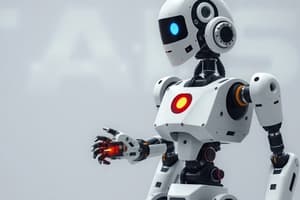Podcast
Questions and Answers
What is one strategy the team is using to optimize their robot's performance?
What is one strategy the team is using to optimize their robot's performance?
- Limiting the number of missions to focus on quality
- Experimenting with different attachments for each mission
- Using the same attachment and the same program multiple times (correct)
- Changing attachments frequently to adapt to challenges
How many times did the team recreate their robot's design during the season?
How many times did the team recreate their robot's design during the season?
- Three times (correct)
- Five times
- Once
- Twice
Which feature was added to the robot to enhance its efficiency during missions?
Which feature was added to the robot to enhance its efficiency during missions?
- Enhanced motor power (correct)
- Remote control functionality
- Increased wheel size
- Additional sensors
What programming tool did the team learn to improve the robot's coding?
What programming tool did the team learn to improve the robot's coding?
What was a significant change made to the team's programming approach this year?
What was a significant change made to the team's programming approach this year?
How did the team's collaborative approach impact their efficiency?
How did the team's collaborative approach impact their efficiency?
What type of wheels did the robot have to improve traction?
What type of wheels did the robot have to improve traction?
What aspect of the robot's design was emphasized to ensure speed and efficiency?
What aspect of the robot's design was emphasized to ensure speed and efficiency?
Flashcards
Robot Design Process
Robot Design Process
The process of creating and improving a robot's design, often involving multiple iterations and feedback.
Robot Innovation
Robot Innovation
Adding new features or improvements to a robot that enhance its functionality or capabilities.
Robot Mechanical Design
Robot Mechanical Design
The physical structure of a robot, including its components, shape, and size.
Robot Programming
Robot Programming
Signup and view all the flashcards
Reusing Program and Attachment
Reusing Program and Attachment
Signup and view all the flashcards
Single Mission Approach
Single Mission Approach
Signup and view all the flashcards
Collaborative Design
Collaborative Design
Signup and view all the flashcards
Robotics Fun
Robotics Fun
Signup and view all the flashcards
Study Notes
Robot Design and Development
- Robot Specifications:
- 4 drive motors
- 2 color sensors
- Rubber wheels with flat surfaces for good traction
- 2 attachments
Design Process
- Iterative Design: The robot design underwent 3 iterations.
- Initial robot was too large.
- Second robot lacked sufficient strength.
- Design improvements were driven by research, specifically on gears, and using video tutorials.
- Collaborative Design: Multiple team members (at least 3 per attachment) contributed to the design and improvement of each attachment.
Innovation and Strategy
- Adaptive Design: Incorporated research and successful strategies from other teams.
- Dynamic Power Adjustment: Increased motor power for certain missions and refined coding adjustments.
- Improved Coding Techniques: Utilized "my blocks" for easier and more precise turns in various degrees. This technique was integrated into all missions.
- Strategic Mission Approach: Often used the same attachment and program multiple times to reduce game downtime.
- Focus on Single Missions: Limited to single missions in the initial season to grow comfort and efficiency.
Mechanical Design
- Compact and Efficient: The robot maintains a compact size with a simple, yet fast and efficient design.
- Attachment Retention: Same attachment used for multiple missions to maximize game efficiency unless necessary.
Programming
- Continuous Testing and Refinement: Active testing and adjustments made to improve program accuracy throughout the season.
- Portable Coding Platform: Utilized a portable laptop for flexibility in last-minute program adjustments.
Team Dynamics and Enjoyment
- Collaborative Problem Solving: Teamwork led to quicker and better mission completion and resulted in more enjoyable and efficient meetings.
- Increased Enjoyment: Programming was initially challenging but became enjoyable as the team mastered the required skills.
Studying That Suits You
Use AI to generate personalized quizzes and flashcards to suit your learning preferences.





